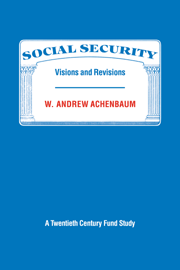Book contents
- Frontmatter
- Contents
- Dedication
- Foreword
- Acknowledgments
- Introduction
- Part I Social security comes of age
- Part II Current social security issues in historical perspective
- 5 Retirement under social security
- 6 Social security and the modern American woman
- 7 Universal coverage: an either/or proposition?
- 8 Federal health care programs and social security
- 9 A vision renewed: individual needs and mutual responsibility
- Notes
- Index
6 - Social security and the modern American woman
Published online by Cambridge University Press: 04 August 2010
- Frontmatter
- Contents
- Dedication
- Foreword
- Acknowledgments
- Introduction
- Part I Social security comes of age
- Part II Current social security issues in historical perspective
- 5 Retirement under social security
- 6 Social security and the modern American woman
- 7 Universal coverage: an either/or proposition?
- 8 Federal health care programs and social security
- 9 A vision renewed: individual needs and mutual responsibility
- Notes
- Index
Summary
Discussing the changes in retirement age has required primary attention to the needs of “typical” wage earners. This kind of analysis is consistent with the basic principles of social security policymaking. In determining Title II benefits, “there seems to be a consensus of response, in America at least, that the starting point in the procedure is the establishment of normal status.” Social insurance, in this view, deals with the major risks that Americans are likely to face during their “normal” working lives. But what happens when the needs of subgroups do not conform to such patterns? Can rules keyed to averages take account of the diversity in employment paths and family relationships in the United States?
Critics claim that social security treats women and minorities unfairly. True, the same rules apply to everybody, but not all groups live by the same “rules.” OASDHI's methods of determining eligibility have evolved in ways that militate against the interests of those whose employment and earnings histories differ from those of “average” white males. Moreover, differences in marital status and life expectancy exacerbate the situation; some benefit unduly, whereas others are penalized by formulas that apply a single – admittedly complex – set of criteria to all.
Public officials have been more responsive to women's demands than to those of minorities. As this chapter shows, both the courts and a succession of high-level panels have sought to eliminate gender discrimination.
- Type
- Chapter
- Information
- Social SecurityVisions and Revisions: A Twentieth Century Fund Study, pp. 124 - 141Publisher: Cambridge University PressPrint publication year: 1986



